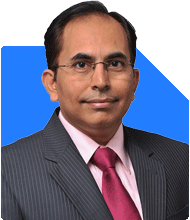Which Mutual Fund is Best for Me in November 2023?
Ramalingam Kalirajan |10017 Answers |Ask -Follow
Mutual Funds, Financial Planning Expert - Answered on Apr 11, 2025
He has an MBA in finance from the University of Madras and is a certified financial planner.
He is the director and chief financial planner at Holistic Investment, a Chennai-based firm that offers financial planning and wealth management advice.... more

which mutual fund can i invest at present time
Now let's see the right fund types to invest in at present.
Assess Your Time Horizon
If your goal is 5 years or less, equity funds are not ideal.
For medium to long-term goals, equity mutual funds can give better returns than FDs.
For very short-term goals, debt funds or hybrid conservative funds are better.
Always match your investment to your goal time frame.
Define Your Risk Profile
If you cannot handle ups and downs, avoid small cap and mid cap funds.
If you are okay with risk and waiting for long, consider diversified equity funds.
If your risk appetite is low, use hybrid or balanced advantage funds.
For moderate risk, large and mid cap funds or flexi cap funds are suitable.
Opt for Actively Managed Funds
Index funds follow the market blindly. They never beat it.
In bad market times, index funds give no protection.
Actively managed funds are guided by expert fund managers.
These fund managers use insights to avoid risky sectors.
Active funds have more scope to outperform. Especially in volatile times.
If you want better returns and managed risk, always go for actively managed funds.
Avoid Direct Mutual Funds
Direct funds need full research and ongoing tracking.
Wrong choice in direct funds can cost you big.
Many investors miss rebalancing and fund switches at the right time.
With regular funds, you get support from a certified financial planner.
Regular plans give advice, reviews, and goal tracking help.
Paying a small commission in regular funds gives you full support.
That is worth much more than the 0.5%-1% cost.
Recommended Fund Categories
Let’s now break this into fund categories for your better understanding.
Large Cap Funds
Invest in top companies with strong balance sheets.
Less volatile than small and mid cap funds.
Good for conservative and first-time investors.
Suitable for long-term wealth creation with stability.
Can be 25%-30% of your portfolio.
Flexi Cap Funds
These funds invest in large, mid, and small companies.
Fund managers have more freedom to pick good stocks.
They offer good balance of growth and safety.
Ideal for medium to high risk investors.
Can be 20%-25% of your portfolio.
Large & Mid Cap Funds
By rule, 35% goes in large and 35% in mid cap companies.
This makes it suitable for balanced growth.
Slightly higher return potential than large cap funds.
Good for medium to long-term goals.
Allocate around 20% of your portfolio.
Mid Cap Funds
Good for 7+ year goals.
Mid-size companies can grow faster than large caps.
But they are more volatile.
Don’t invest unless you have patience.
Keep only 10%-15% in mid cap funds.
Small Cap Funds
Invest only if your goal is 10 years away.
Returns can be very high in long-term.
But risk and falls can be extreme.
Invest only 5%-10% of your corpus.
SIP route is better than lump sum in small cap.
Focused Funds
They invest in only 20-30 stocks.
Not suitable for new or conservative investors.
High potential if managed well.
Risk is higher due to concentrated portfolio.
Use only if you understand fund’s strategy.
Debt Mutual Funds for Low Risk
These are best for parking money for short-term needs.
Safer than equity funds, but returns are moderate.
Now taxed as per your income tax slab.
Still better than FDs in terms of post-tax returns if you are in lower tax slab.
Options include short duration, ultra short, or liquid funds.
Don’t expect very high returns. But useful for stability.
Hybrid Funds for Balanced Investing
Mix of equity and debt.
Gives smoother returns than full equity funds.
Good for beginners or medium risk investors.
Balanced Advantage Funds adjust equity-debt mix automatically.
Equity Savings Funds offer better safety with mild growth.
These can be 15%-20% of your portfolio.
SIP vs Lump Sum
If you have a big amount, don’t invest all in one go.
Use STP (Systematic Transfer Plan) to move it slowly to equity fund.
SIP is best for regular investing and averaging cost.
Keep increasing SIP yearly by 10%-15%.
Use a mix of SIP and STP based on your cash flow.
Rebalancing Is Very Important
Review funds every year with your certified financial planner.
Remove underperforming schemes regularly.
Rebalance between debt and equity based on goal.
Avoid emotional decisions when market falls.
This ensures your portfolio remains healthy.
Tax Implications You Must Know
New rules apply to equity mutual funds.
Long-term gains above Rs 1.25 lakh taxed at 12.5%.
Short-term gains are taxed at 20%.
For debt funds, all gains are taxed as per your slab.
Plan redemptions smartly to save tax.
Use tax loss harvesting where needed.
Goal Mapping Is a Must
Don’t invest blindly. Always map your goals first.
Break your goals as short, mid and long-term.
Then decide which fund type suits each goal.
Keep emergency fund separate in liquid fund.
Review goal progress every year.
Finally
Equity mutual funds are best for wealth creation.
Choose actively managed funds over index funds.
Use regular plans with a certified financial planner for full support.
Match fund category to your goals and risk level.
Avoid LIC, ULIPs and annuity plans.
Review, rebalance, and reinvest every year.
Your discipline matters more than fund performance.
Keep calm and stay invested for the long run.
Best Regards,
K. Ramalingam, MBA, CFP,
Chief Financial Planner,
www.holisticinvestment.in
https://www.youtube.com/@HolisticInvestment
You may like to see similar questions and answers below
Ulhas Joshi | Answer |Ask -Follow
Mutual Fund Expert - Answered on Apr 18, 2023
Ramalingam Kalirajan |10017 Answers |Ask -Follow
Mutual Funds, Financial Planning Expert - Answered on Jun 29, 2024
Ramalingam Kalirajan |10017 Answers |Ask -Follow
Mutual Funds, Financial Planning Expert - Answered on Jul 19, 2024
Ramalingam Kalirajan |10017 Answers |Ask -Follow
Mutual Funds, Financial Planning Expert - Answered on Aug 30, 2024
Ramalingam Kalirajan |10017 Answers |Ask -Follow
Mutual Funds, Financial Planning Expert - Answered on Jan 20, 2025
Janak Patel |63 Answers |Ask -Follow
MF, PF Expert - Answered on Jul 31, 2025
Nayagam P P |9745 Answers |Ask -Follow
Career Counsellor - Answered on Jul 31, 2025
Radheshyam Zanwar |6014 Answers |Ask -Follow
MHT-CET, IIT-JEE, NEET-UG Expert - Answered on Jul 31, 2025
Nayagam P P |9745 Answers |Ask -Follow
Career Counsellor - Answered on Jul 31, 2025
Samraat Jadhav |2407 Answers |Ask -Follow
Stock Market Expert - Answered on Jul 31, 2025
Samraat Jadhav |2407 Answers |Ask -Follow
Stock Market Expert - Answered on Jul 31, 2025
Radheshyam Zanwar |6014 Answers |Ask -Follow
MHT-CET, IIT-JEE, NEET-UG Expert - Answered on Jul 31, 2025

Both are good options. Considering the opportunities in the tech field and the manpower demand, it is advisable to pursue AI+ML @ BIT Mesra for careers focused on software and AI.
Good luck.
Follow me if you receive this reply..
Radheshyam
Radheshyam Zanwar |6014 Answers |Ask -Follow
MHT-CET, IIT-JEE, NEET-UG Expert - Answered on Jul 31, 2025
Radheshyam Zanwar |6014 Answers |Ask -Follow
MHT-CET, IIT-JEE, NEET-UG Expert - Answered on Jul 31, 2025
Radheshyam Zanwar |6014 Answers |Ask -Follow
MHT-CET, IIT-JEE, NEET-UG Expert - Answered on Jul 31, 2025





















